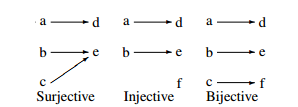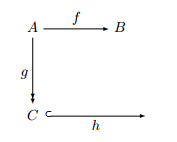

تاريخ الرياضيات

الاعداد و نظريتها

تاريخ التحليل

تار يخ الجبر

الهندسة و التبلوجي


الرياضيات في الحضارات المختلفة

العربية

اليونانية

البابلية

الصينية

المايا

المصرية

الهندية


الرياضيات المتقطعة

المنطق

اسس الرياضيات

فلسفة الرياضيات

مواضيع عامة في المنطق


الجبر

الجبر الخطي

الجبر المجرد

الجبر البولياني

مواضيع عامة في الجبر

الضبابية

نظرية المجموعات

نظرية الزمر

نظرية الحلقات والحقول

نظرية الاعداد

نظرية الفئات

حساب المتجهات

المتتاليات-المتسلسلات

المصفوفات و نظريتها

المثلثات


الهندسة

الهندسة المستوية

الهندسة غير المستوية

مواضيع عامة في الهندسة

التفاضل و التكامل


المعادلات التفاضلية و التكاملية

معادلات تفاضلية

معادلات تكاملية

مواضيع عامة في المعادلات


التحليل

التحليل العددي

التحليل العقدي

التحليل الدالي

مواضيع عامة في التحليل

التحليل الحقيقي

التبلوجيا

نظرية الالعاب

الاحتمالات و الاحصاء

نظرية التحكم

بحوث العمليات

نظرية الكم

الشفرات

الرياضيات التطبيقية

نظريات ومبرهنات


علماء الرياضيات

500AD

500-1499

1000to1499

1500to1599

1600to1649

1650to1699

1700to1749

1750to1779

1780to1799

1800to1819

1820to1829

1830to1839

1840to1849

1850to1859

1860to1864

1865to1869

1870to1874

1875to1879

1880to1884

1885to1889

1890to1894

1895to1899

1900to1904

1905to1909

1910to1914

1915to1919

1920to1924

1925to1929

1930to1939

1940to the present

علماء الرياضيات

الرياضيات في العلوم الاخرى

بحوث و اطاريح جامعية

هل تعلم

طرائق التدريس

الرياضيات العامة

نظرية البيان
Functions-One–one, Onto, and Bijective Functions
المؤلف:
Ivo Düntsch and Günther Gediga
المصدر:
Sets, Relations, Functions
الجزء والصفحة:
39-41
14-2-2017
7332
Definition 1.1. Let f : A → B be a function.
1. f is called onto or surjective if codom f = ran f. If f is surjective, we sometimes indicate this by writing f : A ։ B.
2. f is called one–one or injective if for all x, y ∈ A, f(x) = f(y) implies x = y. If f is injective, we sometimes indicate this by writing f : A → B.
3. f is called bijective if f is onto and one-one.
Thus, f is onto if, in the pictorial representation, at least one arrow arrives at every element of the codomain; in other words, for every y ∈ codom f there exists at least one element x of dom f with f(x) = y. If f is one–one, then at most one arrow arrives at every element of codom f. If f is bijective, then exactly one arrow arrives at every element of codom f, see Figure 1.1.
Figure 1.1: Types of functions

Example 1.1.
- f : R → R, f(x) = 2x:
f is one–one: We have to show that for all x,y ∈ R,f(x) = f(y) implies x = y. So let f(x) = f(y); by definition of f, f(x) = 2x and f(y) = 2y.
Since f(x) = f(y), the definition of f tells us that 2x = 2y, which implies x = y.
f is onto: For every real number y we have to find a real number x such that f(x) = y, which, by our definition of f is the same as 2x = y. Solving this equation for x gives us x =y/2; so, f(y/2) = y.
Since f is one–one and onto, it is bijective.
2. f : R → R, f(x) = x2:
f is not one–one: To show that an object does not have a certain property, it is enough to exhibit one counterexample, So, to show that f is not one–one we have to find two different real numbers x and y such that f(x) = f(y).
This is easily done by choosing x = 1 and y = −1.
f is not onto: Again, we have to find just one counterexample. If e.g. y = −1, then for no real number x we have f(x) = y, since the square of a real number is never negative.
3. Let R+ be the set of positive real numbers and define f : R → R+ by f(x) = x2.
Observe that we have only changed the codomain of the previous example. The function still is not one–one, but now it is onto, since every positive real number is a square.
4. Let f : R+ → R be defined by f(x) = x2.
We have only changed the domain of f from Example 2. This function is not onto – the codomain is still all of R, and negative numbers still cannot be squares of real numbers.
But our new f is one–one, since every real number has at most one positive root.
These examples tell us that the properties of being one–one or onto depend not only on the rule of assignment, but also on the domain and the codomain of the function. In fact, by changing the codomain of a function, we can always obtain a surjective function with the same domain and the same rule of assignment:
Lemma 1.1. Let f : A → B be a function; then g : A → ran f defined by g(x) = f(x) for all x ∈ A is onto.
Proof. Since dom f = dom g, and g(x) = f(x) for all x ∈ A, g is a function. To show that g is onto, let y ∈ codom g. By our definition of g, codom g = ran f; thus there is an x ∈ A = dom f such that f(x) = y. Now, since dom f = dom g we have x ∈ dom g; furthermore, since f(x) = g(x), we obtain g(x) = y. This shows that g is onto.
Each function f : A → B can be written as a composition f = h ◦ g of functions, where g is surjective, and h is injective. This is an important Theorem which is used in many algebraic contexts. To prepare for a proof, we need
Definition 1.2. Let f : A → B be a function. Then the canonical equivalence relation θf of f is defined by
xθf y ⇐⇒ f(x) = f(y)
for all x,y ∈ A.
The set {θfx : x ∈ A} of equivalence classes of θf is called the quotient set of A with respect to f, written as A/θf , or simply quotient set, if f is understood.
Theorem 1.2. Let f : A → B be a function. Then, there are a set C, and functions g : A ։ C, h : C→ B such that g is surjective, h is injective, and f = h ◦ g.
The situation is picture in Figure 1.2
Figure 1.2: Mapping Theorem

Proof. Set C = A/θf , and letg : A → A/θf be defined by x g→ θfx. Since each element of A is contained in exactly one class of E(θf ), h is a surjective function.
Now, let h : A/θf → B be defined as follows: Let t ∈ A/θf . Then, there is some x ∈ A, such that t = θfx; set h(t) = f(x). We need to show that the definition of h is independent of the choice of the representative x of the class t. Thus, let y ∈ θfx. By definition of θf , we have xθf y if and only if f(x) = f(y), and it follows that f(y) = f(x) for all y ∈ θfx.
Finally,
(g ◦ h)(x) = g(θfx) = f(x),
which proves our claim.
 الاكثر قراءة في نظرية المجموعات
الاكثر قراءة في نظرية المجموعات
 اخر الاخبار
اخر الاخبار
اخبار العتبة العباسية المقدسة

الآخبار الصحية















 قسم الشؤون الفكرية يصدر كتاباً يوثق تاريخ السدانة في العتبة العباسية المقدسة
قسم الشؤون الفكرية يصدر كتاباً يوثق تاريخ السدانة في العتبة العباسية المقدسة "المهمة".. إصدار قصصي يوثّق القصص الفائزة في مسابقة فتوى الدفاع المقدسة للقصة القصيرة
"المهمة".. إصدار قصصي يوثّق القصص الفائزة في مسابقة فتوى الدفاع المقدسة للقصة القصيرة (نوافذ).. إصدار أدبي يوثق القصص الفائزة في مسابقة الإمام العسكري (عليه السلام)
(نوافذ).. إصدار أدبي يوثق القصص الفائزة في مسابقة الإمام العسكري (عليه السلام)


















